The short unhappy life of Ernest Hemingway
Mar 19th, 2009 | By L. Frank Bunting | Category: Entertainment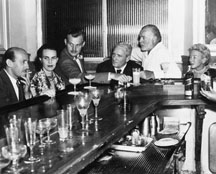 I discovered Ernest Hemingway’s lean and evocative writing as a teenager in high school. For a few years he was the hero of my adolescence. Then he blew his head off with a shotgun in 1961. By 1964, when his memoir of his triumphant young adulthood in Paris was published posthumously, I had left Hemingway and high school behind. He had become just a door to somewhere else.
I discovered Ernest Hemingway’s lean and evocative writing as a teenager in high school. For a few years he was the hero of my adolescence. Then he blew his head off with a shotgun in 1961. By 1964, when his memoir of his triumphant young adulthood in Paris was published posthumously, I had left Hemingway and high school behind. He had become just a door to somewhere else.
There are many similar stories in the naked city nowadays, no doubt. I was reminded of mine in early February 2009, when I read the cutely headlined article “For whom the camera rolls: Ernest Hemingway biopic set for big screen,” on the guardian.co.uk website. (Hemingway’s 1940 novel of the Spanish Civil War, in case you’ve forgotten, is called For Whom the Bell Tolls.) The article set me off on a leisurely stroll through “Ernest Hemingway” on Google Images. At the moment, I own only one book by Hemingway and one book about him. But before an accidental episode of creative destruction between college and my first full-time job, I had almost all his major works (novels and short stories) and a number of books about him. I had seen several Hemingway photographs, and heard recordings of his voice. I have just now, however, learned much more from Google Images. What a difference the world wide web has made!
NOTE FROM COUNTERWEIGHTS EDITORS: Mr. Bunting has provided an extended discussion of Ernest Hemingway’s life and more recent opinions about his writing. If you already know about the life, you may want to skip the first six sections below and go directly to section 7. Other readers may only be interested in the first six sections on the life. Still others may just want to look at the photographs, which are identified and briefly annotated at the very end of the piece.
1. Fate of Tom Sawyer in 20th century
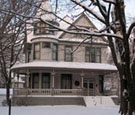 Ernest Miller Hemingway was born at the very end of the 19th century, on 21 July 1899. His father was a medical doctor, and the family lived in an upscale Chicago suburb called Oak Park.
Ernest Miller Hemingway was born at the very end of the 19th century, on 21 July 1899. His father was a medical doctor, and the family lived in an upscale Chicago suburb called Oak Park.
There are baby pictures on the net, but they don’t say much to me. The early family home at 339 North Oak Park Avenue, where Ernest spent his first six years, is more 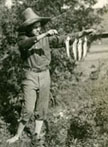 revealing. It was restored during the 1999 centenary of his birth, and is now operated as “The Ernest Hemingway Birthplace Home” by The Ernest Hemingway Foundation of Oak Park (adult admission $8).
revealing. It was restored during the 1999 centenary of his birth, and is now operated as “The Ernest Hemingway Birthplace Home” by The Ernest Hemingway Foundation of Oak Park (adult admission $8).
Hemingway’s highest formal education took place at Oak Park High School. This seems to have been a good public institution of its time and place, in an upper middle class neighbourhood.
The young Ernest was probably more deeply marked by his family’s summer home on Walloon Lake in northern Michigan. Here he learned the ancient manly arts of hunting and fishing, which he would pursue for the rest of his life. There are photographs of him as a Tom-Sawyerish boy of summer on Walloon Lake. The adult Hemingway would call Mark Twain’s Adventures of Huckleberry Finn the book from which “all modern American literature comes.” And Hemingway was himself a Tom Sawyer of sorts, whose at least theoretically idyllic youth in the American Midwest was shattered by the horrors of the First World War in Europe.
2. Adventures of young man in Italy and the North American Great Lakes
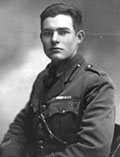 Hemingway’s literary ambitions had crystallized even before high school, when he attended Oliver Wendell Holmes Elementary School in Oak Park. In a notebook from this period that has been preserved he wrote: “My favourite authors are Kipling, O. Henry and Steuart Edward White … I intend to travel and write.”
Hemingway’s literary ambitions had crystallized even before high school, when he attended Oliver Wendell Holmes Elementary School in Oak Park. In a notebook from this period that has been preserved he wrote: “My favourite authors are Kipling, O. Henry and Steuart Edward White … I intend to travel and write.”
He did not go on to college when he graduated from Oak Park High School in 1917. But with the help of family connections he found a job as a cub reporter at the Kansas City Star. And this at least got his literary ambitions started.
The United States had joined the First World War in 1917, several months before Hemingway began his first job in Kansas City. He tried to enlist but was rejected because of poor vision. To further his travelling ambitions, he was subsequently accepted as an ambulance driver for the American Red Cross in Italy. He arrived at Garibaldi Station in Milan on 7 June 1918.
Not much more than a month after his arrival, Hemingway was hit in the legs by machine-gun fire on the Italian front along the Piave River. He spent the rest of the war recovering from his wounds back in Milan – and falling in unrequited love with a 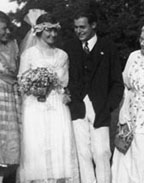 nurse at the hospital there. (All of which he would write about in his 1929 novel, A Farewell to Arms. Almost everything Hemingway wrote about in his literary career was vaguely autobiographical.)
nurse at the hospital there. (All of which he would write about in his 1929 novel, A Farewell to Arms. Almost everything Hemingway wrote about in his literary career was vaguely autobiographical.)
Hemingway returned to Oak Park in January 1919. He had been awarded the Italian Silver Cross, and was something of a local war hero back in the USA. Along with insurance money from his war wounds this gave him an initial postwar career. Then family connections helped him find another job in journalism, this time at the Toronto Star — in the Canadian urban wilderness only a few hundred miles east of the Hemingway summer home in northern Michigan.
After a first short stint in Toronto Hemingway moved back to Chicago. Here he continued to write articles for the Toronto Star, and for a publication called The Cooperative Commonwealth. He also met and fell in love with Hadley Richardson, a piano teacher from St. Louis who was eight years older than him, and quickly became a strong supporter of his literary ambitions. Ernest and Hadley were married at Horton Bay, near Walloon Lake, in the summer of 1921. Then Hemingway wangled a job as European correspondent for the Toronto Star. By late December 1921 he and Hadley were in Paris, where his literary career would very seriously begin.
3. Americans in Paris : Ernest and Hadley Hemingway
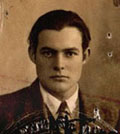 By the time he arrived in Paris Hemingway had already managed to befriend writers like Sherwood Anderson and Carl Sandburg in Chicago. His wartime adventures had helped make him an assured and impressive young man, full of entrepreneurial zeal for his writing ambitions beyond journalism. Something of all this shines out from his 1923 passport photograph.
By the time he arrived in Paris Hemingway had already managed to befriend writers like Sherwood Anderson and Carl Sandburg in Chicago. His wartime adventures had helped make him an assured and impressive young man, full of entrepreneurial zeal for his writing ambitions beyond journalism. Something of all this shines out from his 1923 passport photograph.
Sherwood Anderson (author of Winesburg, Ohio) gave Hemingway letters of introduction to writers in Paris who were helping advance what the English critic Cyril Connolly would later call The Modern Movement in the literature of “England, France, and America.” Hemingway especially learned from the American experimental writer Gertrude Stein (author of The Autobiography of Alice B. Toklas), who was also immersed in the Paris art scene of the 1920s.
In 1923 Ernest and Hadley returned for a time to Toronto, where Hadley gave birth to John (Jack) Hemingway. (Jack would much later become the father of the movie actresses Margaux and Mariel Hemingway.) Soon enough, however, Ernest and Hadley were back in Paris (with some support from a trust fund of Hadley’s). Here, 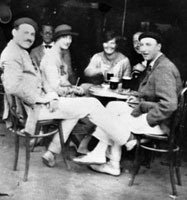 after much joyous and disciplined hard work, Hemingway completed two striking books that made his reputation as an innovative and influential literary stylist, in the era after the First World War.
after much joyous and disciplined hard work, Hemingway completed two striking books that made his reputation as an innovative and influential literary stylist, in the era after the First World War.
The first book was a collection of short stories called In Our Time, first published in a limited edition in Paris in 1924, and then more commercially in New York in 1925. The second was a novel called The Sun Also Rises – a thinly veiled fictional account of the European (and especially Spanish) adventures of Hemingway and his American expatriate and other friends in Paris, first published in New York in 1926.
In Our Time, the critic Cyril Connolly wrote in the 1960s, “is a sequence of father-haunted short stories about the author`s boyhood in Michigan, counterpointed by prose poems depicting the horrors of war ” (in Europe). The Sun Also Rises is a “short picaresque novel ” in which “the post-war disillusion and the post-war liberation are united in the physical enjoyment of living and the pains of love. Perhaps that is what expatriation was about.”
Connolly goes on: “The combined effect of these two books … was overwhelming. No other writer … stepped so suddenly into fame, or destroyed … so many other writers or ways of writing or became such an immediate symbol of an age.”
4. Ernest and Pauline Hemingway at Key West …Â in Spain, Africa, Wyoming, etc, etc
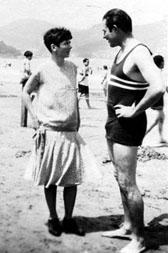 One early casualty of Hemingway’s sudden literary success was his marriage to Hadley Richardson. The short story here is that Hadley became friends with Pauline Pfeiffer, an assistant to the Paris editor of Vogue magazine. Pauline began to travel and otherwise spend time with the Hemingways in Paris. She was only four years older than Ernest, and apparently had a considerably larger trust fund than Hadley. Soon enough Ernest was sleeping with Pauline. Then in the spring of 1927 he divorced Hadley, and married Pauline.
One early casualty of Hemingway’s sudden literary success was his marriage to Hadley Richardson. The short story here is that Hadley became friends with Pauline Pfeiffer, an assistant to the Paris editor of Vogue magazine. Pauline began to travel and otherwise spend time with the Hemingways in Paris. She was only four years older than Ernest, and apparently had a considerably larger trust fund than Hadley. Soon enough Ernest was sleeping with Pauline. Then in the spring of 1927 he divorced Hadley, and married Pauline.
By early 1928 Ernest and Pauline had left Paris. On April 7 they arrived in Key West – the most southerly point in the USA, off the coast of Florida. Although they travelled a lot (Ernest having long ago declared “I intend to travel and write”), for the next dozen years Key West remained their base of operations. In 1931 Pauline’s wealthy Uncle Gus, who had become a friend of Ernest’s, bought the couple a house at 907 Whitehead Street “in the heart of Old Town Key West.” It is now known as the “Ernest Hemingway Home and Museum” (adult admission $12).
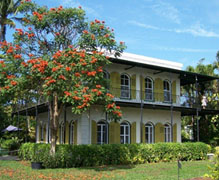 Ernest and Pauline had two sons together, Patrick and Gregory. Pauline’s family were at this point living in Piggott, Arkansas. But both Patrick and Gregory were born in Kansas City – in 1928 and 1931. (So all three of Ernest’s children were born in the two places where he had his first jobs as a newspaper journalist – Toronto and Kansas City. Both places, Hemingway seems to have thought, also had good hospitals in which to have children. In adult life Patrick, the older of Ernest’s sons with Pauline, would become a white hunter in East Africa. Gregory would become a wayward medical doctor, who had four wives and eight children. Before he was born his mother and especially his father had hoped that he would be a girl. In his last years he had a sex change operation, and sometimes called himself Gloria or Vanessa.)
Ernest and Pauline had two sons together, Patrick and Gregory. Pauline’s family were at this point living in Piggott, Arkansas. But both Patrick and Gregory were born in Kansas City – in 1928 and 1931. (So all three of Ernest’s children were born in the two places where he had his first jobs as a newspaper journalist – Toronto and Kansas City. Both places, Hemingway seems to have thought, also had good hospitals in which to have children. In adult life Patrick, the older of Ernest’s sons with Pauline, would become a white hunter in East Africa. Gregory would become a wayward medical doctor, who had four wives and eight children. Before he was born his mother and especially his father had hoped that he would be a girl. In his last years he had a sex change operation, and sometimes called himself Gloria or Vanessa.)
Ernest’s marriage to Pauline lasted about twice as long as his marriage to Hadley: “Pauline remained deeply in love with Hemingway all her life and sacrificed much to be with him, including, perhaps, her own sons, Patrick and Gregory. By her own admission, she was not cut out to be a mother and was forced often into a choice of either being with Ernest or with her children. She chose Ernest, trying not to lose him, and her children were often left in the care of their nurse, their grandparents in Piggott, or their Aunt Virginia. Gregory stated publicly that he often felt abandoned as a child, and that his relationship with his mother was never a close one.”
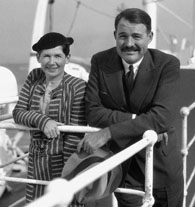 Along with Key West and Piggott, Arkansas, Ernest and Pauline were in Europe in 1929 (including Paris, Berlin, and, already Hemingway’s favourite place, Spain). In 1930 they spent time in Wyoming and Montana, where Ernest began his long romance with the far American West. In 1931 and 1932 it was Key West, Kansas City, Arkansas, and Wyoming. In 1933 Ernest went fishing in Cuba; then he and Pauline were off to Europe, and then, at the end of the year, to East Africa, for Ernest’s first safari. They left Africa for Paris at the end of February 1934, and arrived back in Key West in the middle of April. There was tuna fishing in Bimini in the Bahamas in 1935 and 1936, and more time in Cuba and Wyoming. Ernest and then Ernest and Pauline were back in Europe in 1937, and then in Bimini and New York. (Ernest’s trips to Europe during the later 1930s also included his reporting on the Spanish Civil War, 19361939.) In 1938 it was Cuba, Key West, Europe, New York, Wyoming, Europe again, New York again, Cuba, and Key West. In 1939 it was — together and separately (as their marriage unravelled) — Cuba, Key West, Wyoming, New York, Europe, Sun Valley (Idaho), Key West, and Cuba again.
Along with Key West and Piggott, Arkansas, Ernest and Pauline were in Europe in 1929 (including Paris, Berlin, and, already Hemingway’s favourite place, Spain). In 1930 they spent time in Wyoming and Montana, where Ernest began his long romance with the far American West. In 1931 and 1932 it was Key West, Kansas City, Arkansas, and Wyoming. In 1933 Ernest went fishing in Cuba; then he and Pauline were off to Europe, and then, at the end of the year, to East Africa, for Ernest’s first safari. They left Africa for Paris at the end of February 1934, and arrived back in Key West in the middle of April. There was tuna fishing in Bimini in the Bahamas in 1935 and 1936, and more time in Cuba and Wyoming. Ernest and then Ernest and Pauline were back in Europe in 1937, and then in Bimini and New York. (Ernest’s trips to Europe during the later 1930s also included his reporting on the Spanish Civil War, 19361939.) In 1938 it was Cuba, Key West, Europe, New York, Wyoming, Europe again, New York again, Cuba, and Key West. In 1939 it was — together and separately (as their marriage unravelled) — Cuba, Key West, Wyoming, New York, Europe, Sun Valley (Idaho), Key West, and Cuba again.
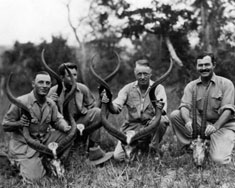 Hemingway’s years with Pauline had their share of literary highlights. A Farewell to Arms, his fictional account of his First World War experiences, still seen by some as his best novel, appeared in 1929. Death in the Afternoon, his nonfiction study on the sport of the bullfight in Spain – still sometimes said to be “the best book on bullfighting in the English language” – appeared in 1932. In 1935 he published The Green Hills of Africa — a second nonfiction study, based on Ernest and Pauline’s East African hunting trip of 19331934. (A character in Jack Kerouac’s 1950s classic On the Road says: “Have you ever read Green Hills of Africa? It’s Hemingway’s best.”) In 1938 a book called The Spanish Earth presented Hemingway’s commentary for a 1937 documentary film of the same name by Joris Ivens. The film was made to help raise money for the republican side in the Spanish Civil War. (“Much of the carrying power” of the project, it was said at the time, “should be credited to Ernest Hemingway’s commentary … with his … feeling for the people of Spain which comes from his heart.”)
Hemingway’s years with Pauline had their share of literary highlights. A Farewell to Arms, his fictional account of his First World War experiences, still seen by some as his best novel, appeared in 1929. Death in the Afternoon, his nonfiction study on the sport of the bullfight in Spain – still sometimes said to be “the best book on bullfighting in the English language” – appeared in 1932. In 1935 he published The Green Hills of Africa — a second nonfiction study, based on Ernest and Pauline’s East African hunting trip of 19331934. (A character in Jack Kerouac’s 1950s classic On the Road says: “Have you ever read Green Hills of Africa? It’s Hemingway’s best.”) In 1938 a book called The Spanish Earth presented Hemingway’s commentary for a 1937 documentary film of the same name by Joris Ivens. The film was made to help raise money for the republican side in the Spanish Civil War. (“Much of the carrying power” of the project, it was said at the time, “should be credited to Ernest Hemingway’s commentary … with his … feeling for the people of Spain which comes from his heart.”)
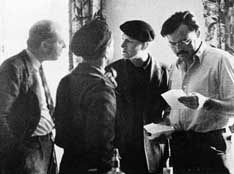 It has often been said that Hemingway was better at writing short stories than novels. Three collections of short stories appeared during his time with Pauline Pfeiffer – Men Without Women (1927), Winner Take Nothing (1933) and The Fifth Column and the First Forty-nine Stories (1938 – The Fifth Column was a play about the Spanish Civil War).
It has often been said that Hemingway was better at writing short stories than novels. Three collections of short stories appeared during his time with Pauline Pfeiffer – Men Without Women (1927), Winner Take Nothing (1933) and The Fifth Column and the First Forty-nine Stories (1938 – The Fifth Column was a play about the Spanish Civil War).
As good as he was at writing them, not all Hemingway’s short stories are perfect. According to the present-day critic and Hemingway literary historian, Robert Fleming: “While most of the reviews of Winner Take Nothing were favourable … nearly all of the reviewers expressed some reservations about the book.” In 1937 Ernest also published To Have and Have Not, which “holds a dubious place in Hemingway’s canon, as it constitutes clearly his worst novel.” (For better or worse, the novel had as well “all of the qualities — relative brevity, a preponderance of dialogue, a strong leading character — to make it a good candidate for conversion to film.” On a fishing trip in 1939, director Howard Hawks told Hemingway “I can make a picture out of your worst story … That god damned bunch of junk called To Have and To Have Not.” Even this bunch of junk, however, does have some impressive fans. According to the English critic Cyril Connolly, Hemingway’s “socially conscious novel To Have and Have Not was not a success although it is quite one of his best books, beautifully constructed and marvellously written.”)
5. Hemingway and Martha Gellhorn in Cuba … Honolulu, Sun Valley, China, etc, etc
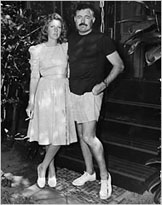 Ernest and Pauline’s marriage began to unravel just before To Have and Have Not was published, when Ernest met the still young but diversely experienced American journalist Martha Gellhorn at Sloppy Joe`s Bar in Key West. “When he told her he was heading to Spain to cover the Spanish Civil War, she decided to go too. She came to Madrid in the spring of 1937 carrying a single knapsack and $50, to cover the war for Collier’s Weekly. Soon Gellhorn, then 28, and Hemingway, 37″ were sleeping together.
Ernest and Pauline’s marriage began to unravel just before To Have and Have Not was published, when Ernest met the still young but diversely experienced American journalist Martha Gellhorn at Sloppy Joe`s Bar in Key West. “When he told her he was heading to Spain to cover the Spanish Civil War, she decided to go too. She came to Madrid in the spring of 1937 carrying a single knapsack and $50, to cover the war for Collier’s Weekly. Soon Gellhorn, then 28, and Hemingway, 37″ were sleeping together.
Ernest had some trouble giving up Pauline (and his family with her – and, some say, her family fortune). He did not marry Martha Gellhorn until November 1940. She appears to me the prettiest of his four wives, but this was also his least successful marriage. It “was difficult. He wanted her to be a deferential wife; she wanted to live life like he did. She was idealistic … he stoically accepted the world as it was. Both had terrible tempers … They broke up in 1945 … at the Dorchester Hotel in London. Afterward, Gellhorn would call Hemingway a bully … he called her phony and pretentious. In later years, she resented having more fame for being Hemingway’s ex-wife than for her own work … Why should I be a footnote to someone else’s life?'”
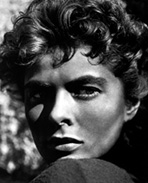 The one high literary achievement of Hemingway’s time with Martha Gellhorn was the publication of his novel For Whom the Bell Tolls in 1940. This was Ernest’s story of the Spanish Civil War. Again it had large elements of thinly veiled autobiography, and it was Martha “after whom Maria, the heroine … was modelled.” (In “the film version of the book, ” which was made in 1943, “Ingrid Bergman played Maria.” Her “hair was darker than Gellhorn’s. However, Gellhorn had suggested her for the role.”)
The one high literary achievement of Hemingway’s time with Martha Gellhorn was the publication of his novel For Whom the Bell Tolls in 1940. This was Ernest’s story of the Spanish Civil War. Again it had large elements of thinly veiled autobiography, and it was Martha “after whom Maria, the heroine … was modelled.” (In “the film version of the book, ” which was made in 1943, “Ingrid Bergman played Maria.” Her “hair was darker than Gellhorn’s. However, Gellhorn had suggested her for the role.”)
Just how high a literary achievement For Whom the Bells Tolls finally amounts to has been debated. Some see it as Hemingway’s most successful novel. Others note that it was just his “biggest commercial success,” and that Hemingway wrote it “without using any of the obscene words he had fought to include in his previous works.” Similarly, in this case he finally “gave in to commercial pressures, writing … to increase the chances of serializing” the book or “selling it to a book club.” Moreover, For Whom the Bell Tolls “was shaped stylistically by Hemingway’s divorce from Pauline Pfeiffer and desire to marry Martha Gellhorn. The novel provided Hemingway with financial independence and the money to maintain the lifestyle he had grown used to in the 1930s, but which he would have lost with the loss of the Pfeiffer family fortune.”
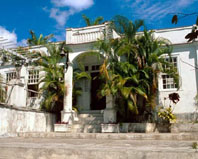 His marriage to Martha also inspired Ernest to move his base of operations from Key West to Cuba. The new couple at first rented and then purchased a large house outside Havana, which they named “Finca Vigia” (“Lookout Farm”). He continued to travel to such earlier haunts as Key West, Wyoming, and Sun Valley. Martha and Ernest had gone to Honolulu for their honeymoon in 1940, and in 1941 they took a long trip together to China. Martha had been hired by Collier’s to cover “the Chinese Army’s retreat from the Japanese invasion.” Ernest “wrote dispatches … for PM Magazine.”
His marriage to Martha also inspired Ernest to move his base of operations from Key West to Cuba. The new couple at first rented and then purchased a large house outside Havana, which they named “Finca Vigia” (“Lookout Farm”). He continued to travel to such earlier haunts as Key West, Wyoming, and Sun Valley. Martha and Ernest had gone to Honolulu for their honeymoon in 1940, and in 1941 they took a long trip together to China. Martha had been hired by Collier’s to cover “the Chinese Army’s retreat from the Japanese invasion.” Ernest “wrote dispatches … for PM Magazine.”
The long trip to China helped surface the growing marital tensions: “Hemingway was glad to return to Cuba for some well deserved rest.” Meanwhile, the Second World War was already underway. In 1942 Hemingway embarked on his own alleged “undercover operation to hunt down German submarines in the Atlantic ocean off the coast of Cuba,” using his fishing boat Pilar, souped up with radio equipment, extra fuel tanks, and “a nice quantity of ordnance” (never actually used on any German submarines).
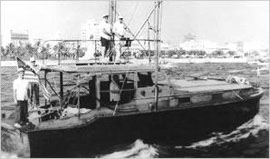 Martha felt that Ernest’s “sub hunts” with friends on Pilar, “fishing and drinking together,” were just his way of “avoiding … [his] responsibilities as a great writer to report the real war then raging in Europe.” For her own part: “During World War II, Gellhorn often left Hemingway behind to go abroad and report. She covered the 1939 Soviet attack on Finland and the German air attacks on London.” By 1944 Ernest was ready to do his duty, and “Hemingway, instead of Gellhorn, was hired by Collier’s to cover the Allies’ D-Day landing in France.”
Martha felt that Ernest’s “sub hunts” with friends on Pilar, “fishing and drinking together,” were just his way of “avoiding … [his] responsibilities as a great writer to report the real war then raging in Europe.” For her own part: “During World War II, Gellhorn often left Hemingway behind to go abroad and report. She covered the 1939 Soviet attack on Finland and the German air attacks on London.” By 1944 Ernest was ready to do his duty, and “Hemingway, instead of Gellhorn, was hired by Collier’s to cover the Allies’ D-Day landing in France.”
 In “late August of 1944 Hemingway and his band of irregular soldiers entered Paris. Hemingway was always fond of saying he was the first to enter Paris en route to its liberation, but the story is a stretch. He did liberate his favorite bar and hotel though. He set up camp in The Ritz Hotel and spent the next week or so drinking, carousing and celebrating his return to the city that meant so much to him as a young man … Next, Hemingway travelled to the north of France to join his friend General Buck Lanham as the allied forces … pushed toward Germany. Hemingway spent a month with Lanham, long enough to watch American forces cross over into Germany …Hemingway returned to America in March of 1946 with plans to write a great novel of the war, but it never materialized.”
In “late August of 1944 Hemingway and his band of irregular soldiers entered Paris. Hemingway was always fond of saying he was the first to enter Paris en route to its liberation, but the story is a stretch. He did liberate his favorite bar and hotel though. He set up camp in The Ritz Hotel and spent the next week or so drinking, carousing and celebrating his return to the city that meant so much to him as a young man … Next, Hemingway travelled to the north of France to join his friend General Buck Lanham as the allied forces … pushed toward Germany. Hemingway spent a month with Lanham, long enough to watch American forces cross over into Germany …Hemingway returned to America in March of 1946 with plans to write a great novel of the war, but it never materialized.”
6. Hemingway and Mary Welsh in Cuba … Italy, Africa, and Spain again … and then the end in Ketchum, Idaho
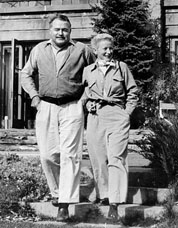 Hemingway’s marriage to Martha Gellhorn and the Second World War officially ended more or less together. But even before the liberation of Paris Ernest had become intimate with Mary Welsh, another American female journalist who was about nine years younger than him – and at the time stationed in London. Mary was “the antithesis of Martha. Mary was caring, adoring, and complimentary while Martha couldn’t care less, had lost any admiration for her man and was often insulting to him.” Mary became Ernest’s fourth and final wife in 1946. His marriage to her would last even longer than his marriage to Pauline Pfeiffer.
Hemingway’s marriage to Martha Gellhorn and the Second World War officially ended more or less together. But even before the liberation of Paris Ernest had become intimate with Mary Welsh, another American female journalist who was about nine years younger than him – and at the time stationed in London. Mary was “the antithesis of Martha. Mary was caring, adoring, and complimentary while Martha couldn’t care less, had lost any admiration for her man and was often insulting to him.” Mary became Ernest’s fourth and final wife in 1946. His marriage to her would last even longer than his marriage to Pauline Pfeiffer.
Hemingway’s early years with Mary Welsh cannot claim high literary achievement. After For Whom the Bell Tolls in 1940, he did not publish another novel until Across the River and Into the Trees in 1950. This was about at least the aftermath of the Second World War, and as usual it included much thinly veiled autobiography. It told the story of a senior US officer sabotaged by superiors, as he fell in love with a young Italian countess, and struggled with an ex-wife (“based on Martha Gellhorn,” again), trying to use his military connections to advance her journalism career. It was “generally slammed by the critics as sentimental, boorish and a thin disguise of Hemingway’s own relationship with a young Italian woman named Adriana Ivancich.”
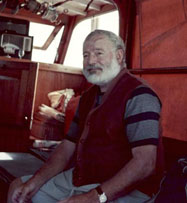 It has also been said that Across the River and Into the Trees “actually contains some of Hemingway’s finest writing.” (And here again a dissenting Cyril Connolly once wrote that he would include “many, many stories, even extracts” from Across the River in his ideal Hemingway anthology.) But the book’s opponents may have done its author a favour: “Stung by the critical reception,” he “was determined to regain his former stature.” He “began work on a story of an old man and a great fish. The words poured forth and hit the page in almost perfect form.” The Old Man and the Sea appeared in September 1952. It “was a huge success both critically and commercially … for the first time since For Whom The Bell Tolls in 1940 Hemingway was atop the literary heap … and making a fortune.” (The book would win the Pulitzer Prize for fiction in 1953 as well, and helped Hemingway win the Nobel Prize for Literature in 1954.)
It has also been said that Across the River and Into the Trees “actually contains some of Hemingway’s finest writing.” (And here again a dissenting Cyril Connolly once wrote that he would include “many, many stories, even extracts” from Across the River in his ideal Hemingway anthology.) But the book’s opponents may have done its author a favour: “Stung by the critical reception,” he “was determined to regain his former stature.” He “began work on a story of an old man and a great fish. The words poured forth and hit the page in almost perfect form.” The Old Man and the Sea appeared in September 1952. It “was a huge success both critically and commercially … for the first time since For Whom The Bell Tolls in 1940 Hemingway was atop the literary heap … and making a fortune.” (The book would win the Pulitzer Prize for fiction in 1953 as well, and helped Hemingway win the Nobel Prize for Literature in 1954.)
Ernest and Mary Welsh had kept on the Cuban base of operations at Finca Vigia (or Lookout Farm) outside Havana. And they had done some modest travelling after the Second World War. (There is a photo of the two of them together at Sun Valley, Idaho in 1947, e.g. And it was on a trip to Venice that they met Adriana Ivancich, who helped inspire an aging author, without, it seems clear, ever consummating any sexual relationship. Ernest called Adriana the daughter he never had, even though the character modelled on her played a quite different role in Across the River and Into the Trees.)
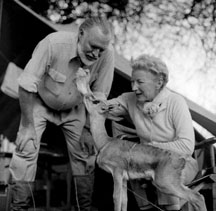 Then, in 1953: “Flush with money from The Old Man and the Sea Hemingway decided to exercise his wanderlust, returning to Europe to catch some bullfights in Spain and then to Africa later in the summer for another safari with his wife Mary.”
Then, in 1953: “Flush with money from The Old Man and the Sea Hemingway decided to exercise his wanderlust, returning to Europe to catch some bullfights in Spain and then to Africa later in the summer for another safari with his wife Mary.”
It was this second trip to Africa that put Ernest on the downhill road which cast such a dark shadow over the rest of his life. The safari went very well during the last four months of 1953. Patrick Hemingway, now in his mid 20s, had already gone into business as an African safari guide, and he helped make the trip a good one for his father. But then in January 1954 Ernest and Mary were in two small-plane crashes, the second of which was quite devastating for Ernest. (“His skull was fractured, two discs of his spine were cracked, his right arm and shoulder were dislocated, his liver, right kidney and spleen were ruptured, his sphincter muscle was paralyzed by compressed vertebrae on the iliac nerve, his arms, face and head were burned by the flames of the plane, his vision and hearing were impaired …”)
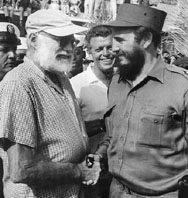 Hemingway “survived the crashes and lived to read his own premature obituaries.” But “his injuries cut short his life in a slow and painful way.” When he won the Nobel Prize for Literature in October 1954, he was “unable to attend the ceremonies in Sweden … due to his injuries … Instead, he sent a written acceptance, read to the Nobel Committee by John Cabot, the US Ambassador to Sweden.” At this point he was only in his mid 50s. But his injuries — and no doubt “his heavy drinking of up to a quart of liquor a day,” to help cope with what seems to have been a pain that never quite went away — were turning him into a prematurely old man.
Hemingway “survived the crashes and lived to read his own premature obituaries.” But “his injuries cut short his life in a slow and painful way.” When he won the Nobel Prize for Literature in October 1954, he was “unable to attend the ceremonies in Sweden … due to his injuries … Instead, he sent a written acceptance, read to the Nobel Committee by John Cabot, the US Ambassador to Sweden.” At this point he was only in his mid 50s. But his injuries — and no doubt “his heavy drinking of up to a quart of liquor a day,” to help cope with what seems to have been a pain that never quite went away — were turning him into a prematurely old man.
In 1956 he spent just over a month at Cabo Blanco in Peru, fishing for marlin in connection with the movie version of The Old Man and the Sea, on a trip paid for by Warner Brothers. In 1959 he spent a last summer with the bullfights in Spain, paid for in part by Life magazine, which finally published a long article on the subject, in three installments in 1960 — “the last work that Hemingway would see published in his lifetime.” By this point Fidel Castro’s revolution had raised questions about Hemingway’s future at his Finca Vigia base of operations in Cuba (even though he was friendly with Castro, and claimed to support the revolution). In April 1959 Ernest and Mary had already bought a house in Ketchum, Idaho, not far from Sun Valley. They left Cuba for good in July 1960, and moved to Ketchum.
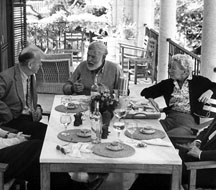 It is hard to know just how to account for the last year of Ernest Hemingway’s life, back in the USA. His physical injuries from Africa in 1954 had only added to earlier injuries sustained in a London car crash a decade before. It seems clear that by 1960 he was in some considerable physical pain much of the time. This no doubt contributed to a severe psychological depression, which prompted admission to the Mayo Clinic in Rochester in the fall of 1960.
It is hard to know just how to account for the last year of Ernest Hemingway’s life, back in the USA. His physical injuries from Africa in 1954 had only added to earlier injuries sustained in a London car crash a decade before. It seems clear that by 1960 he was in some considerable physical pain much of the time. This no doubt contributed to a severe psychological depression, which prompted admission to the Mayo Clinic in Rochester in the fall of 1960.
It seems true enough as well that Hemingway was yet another case of the American artist finally destroyed by commercial celebrity. He had trouble writing ever since the publication of For Whom the Bell Tolls in 1940. With the single exception of The Old Man and the Sea in 1952, nothing he wrote after 1940 quite seemed to work – as it had in his heroic young adulthood.
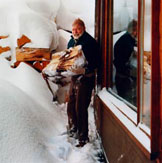 And then there is another grim vein of his family history altogether. His father had committed suicide in 1928, in his late 50s. Similar fates would apparently later befall Ernest’s sister Ursula, his brother Leicester, and his actress granddaughter Margaux Hemingway. (“Some believe that certain members of Hemingway’s paternal line had a hereditary disease known as haemochromatosis [bronze diabetes], in which an excess of iron concentration in the blood causes damage to the pancreas and also causes depression or instability in the cerebrum.”)
And then there is another grim vein of his family history altogether. His father had committed suicide in 1928, in his late 50s. Similar fates would apparently later befall Ernest’s sister Ursula, his brother Leicester, and his actress granddaughter Margaux Hemingway. (“Some believe that certain members of Hemingway’s paternal line had a hereditary disease known as haemochromatosis [bronze diabetes], in which an excess of iron concentration in the blood causes damage to the pancreas and also causes depression or instability in the cerebrum.”)
For whatever exact reasons, he was very unhappy during the last year of his life. The chronology at the back of the 1999 book, Michael Palin’s Hemingway Adventure, tells the final chapter of the story in a very sparse prose that Ernest himself might admire. In 1960 there were: “Two suicide attempts. Treated at the Mayo Clinic with electric shock therapy.” Then in 1961: “Discharged in January. Another suicide attempt in April, returns to clinic. Discharged as cured’ 26 June. 2 July kills himself. Buried in Ketchum cemetery.”
7. Hemingway on the Internet today …
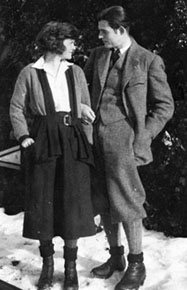 Who can say just what Ernest Hemingway would think about the Internet? And, whatever else, it seems virtually certain that even if the Mayo Clinic had managed to cure him in June 1961, he would never have lived until today. (This July 21, 2009 would be his 110th birthday.)
Who can say just what Ernest Hemingway would think about the Internet? And, whatever else, it seems virtually certain that even if the Mayo Clinic had managed to cure him in June 1961, he would never have lived until today. (This July 21, 2009 would be his 110th birthday.)
There are nonetheless various senses in which something about him does still live on the world wide web. Beyond all the links already noted above, here is a random and altogether casual sample of the great diversity of Hemingwayania now out in cyberspace:
* The Division of Cultural Affairs of the State of Florida inducted Ernest Hemingway into its Florida Artists Hall of Fame in 1987. Its current web page on the subject notes that: “This preeminent literary figure of the 20th century moved to Key West in 1928, living there periodically until 1940. Hemingway wrote all or part of his most famous works including A Farewell to Arms, For Whom the Bell Tolls, and The Snows of Kilimanjaro’ in Key West.”
* In 2001 a Mary M. McKenzie posted what would seem to be a collection of photographs from a trip to Cuba. The collection includes a page on “Ernest Hemingway’s Farm” — which quotes from the Lonely Planet Guide to Cuba: “In 1939, US novelist Ernest Hemingway rented a villa called Finca da Viga on a hill at San Francisco de Paula, 15 km southeast of central Havana. A year later he bought the building, which was erected in 1888, and lived there continuously until 1960, when he moved back to the US … Before leaving, Hemingway donated his estate to the Cuban people, and since 1962, it has housed the Museo Hemingway.”
* The “Finca Viga (Lookout Farm), 15 kilometres from Havana, formerly Hemingway’s Cuban home and converted into a museum in 1962” has also become the present-day resting place of his legendary “fishing boat El Pilar’.” The government of Cuba has recently restored the boat (which is still an important tourist attraction). An intriguing website called Full Moon Fever — Sublime Reflections includes a related 2007 article by Orlando Matos, Inter Press Service (IPS), entitled “Restoring Hemingway’s Yacht.”
* One of the attractions and/or problems of Hemingway’s celebrity in his later career was that it attracted other celebrities — including the movie actress Marlene Dietrich (aka in the Hemingway lexicon “the Kraut”). A net article by Gary Picariello called “Long Distance Love Affair: Ernest Hemingway and Marlene Dietrich” discusses a “cache of thirty love letters donated by Dietrich’s daughter Maria Riva to the John F. Kennedy Library” in 2003. The letters — “written by Hemingway from 1949 and 1953 to Dietrich” — shed light on “what has been a decades-long secret that was passionate, flirtatious but likely just platonic.” (The article also helps explain why so much Hemingway archival material has wound up at the John F. Kennedy Library and Museum in Boston: see, e.g., the list of Photograph Credits below.)
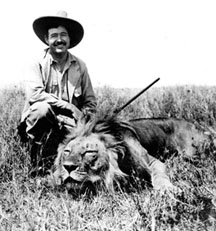 * Beyond such actor friends as Marlene Dietrich (or Spencer Tracy — see the very first photograph above), Hemingway had a chequered relationship with Hollywood movies, in several senses. To start with, cheques for making his books into movies helped sustain the leisured lifestyle of his later career. On the other hand, he almost never liked what Hollywood did with his books and short stories. David Haglund’s “Hollywood Hemingway: How the movies mangled great fiction,” in the Slate online magazine, helps explain all this, in a review of a DVD called The Ernest Hemingway Collection, released by 20th Century Fox in 2007. Haglund nicely summarizes the “peculiar subgenre one might call Hollywood Hemingway: widescreen, Technicolor adaptations featuring foreign settings and doomed love, and always at least half an hour too long. Mostly products of the 1950s, they were made when Hemingway was a living legend and motion picture executives — thanks to the collapse of the studio system and the new ubiquity of television-were deeply insecure.”
* Beyond such actor friends as Marlene Dietrich (or Spencer Tracy — see the very first photograph above), Hemingway had a chequered relationship with Hollywood movies, in several senses. To start with, cheques for making his books into movies helped sustain the leisured lifestyle of his later career. On the other hand, he almost never liked what Hollywood did with his books and short stories. David Haglund’s “Hollywood Hemingway: How the movies mangled great fiction,” in the Slate online magazine, helps explain all this, in a review of a DVD called The Ernest Hemingway Collection, released by 20th Century Fox in 2007. Haglund nicely summarizes the “peculiar subgenre one might call Hollywood Hemingway: widescreen, Technicolor adaptations featuring foreign settings and doomed love, and always at least half an hour too long. Mostly products of the 1950s, they were made when Hemingway was a living legend and motion picture executives — thanks to the collapse of the studio system and the new ubiquity of television-were deeply insecure.”
* Hemingwayania in cyberspace — like everything else on the net — has enormous range: from the lowest lowbrow to very highbrow. An example close to the latter end of things is a December 2007 piece by a writer from Sydney, Australia, Matthew Asprey, called “Reading Notes: Green Hills of Africa by Ernest Hemingway.” If you have ever thought you might like to take Jack Kerouac’s advice and actually read The Green Hills of Africa, but can’t quite imagine when you will ever find the time, this 3700-word article could serve as a reasonable facsimile. Few today, it would seem, are going to approve of everything in the book, Jack Kerouac notwithstanding. As Mr. Asprey sums up: “Sadism aside, Green Hills of Africa is an entertaining work rendering the shape of a country and the pattern of month’s action’ in a form very close to fiction, but it is inevitably limited by Hemingway’s assumption of the frontiersman persona to the exclusion of any wider social perspective.”
8. That Summer in Paris and A Moveable Feast …
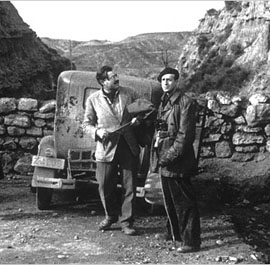 For a working writer Hemingway published surprisingly little during the last two decades of his life. That is, you might guess, partly a tribute to just how commercially successful the books he published during the first two decades of his literary career proved to be — and just how busy he was with the life of leisure and recreation this worldly success supported (making all due allowances for his second wife’s family fortune, and so forth).
For a working writer Hemingway published surprisingly little during the last two decades of his life. That is, you might guess, partly a tribute to just how commercially successful the books he published during the first two decades of his literary career proved to be — and just how busy he was with the life of leisure and recreation this worldly success supported (making all due allowances for his second wife’s family fortune, and so forth).
At the same time, after his death it became clear that he was still writing often enough during his last two decades, even if he did not publish much of what he wrote. For reasons good and bad, perhaps, his estate did go on to publish a great deal of his previously unpublished writing. With one exception, I have not read any of this work myself. I can only note what, e.g., the authors of the current Wikipedia article on Hemingway say: “Some controversy has surrounded the publication of these [posthumously published] works, insofar as it has been suggested that it is not necessarily within the jurisdiction of Hemingway’s relatives or publishers to determine whether these works should be made available to the public.”
My own one exception here is the still quite engaging memoir of the heroic young adulthood in Paris, A Moveable Feast, first published in 1964, some three years after the suicide in Ketchum, Idaho. This was the last of Hemingway’s books that I read enthusiastically in my own youth, not long after it was first published. And I read it back to back with a memoir covering similar ground by the Toronto writer (and friend of Hemingway’s heroic young adulthood) Morley Callaghan, called That Summer in Paris, and first published in 1963 .
I do not want to go into Callaghan’s background much here. Whatever else, his reputation is clearly no match for Hemingway’s. But I do want to note two sentences written by the American critic Edmund Wilson in 1960. First: “The Canadian Morley Callaghan, at one time well known in the United States, is today perhaps the most unjustly neglected novelist in the English-speaking world.” And second: “The reviewer … is now wondering whether the primary reason for the current underestimation of Morley Callaghan may not be simply a general incapacity — apparently shared by his compatriots — for believing that a writer whose work may be mentioned without absurdity in association with Chekhov’s and Turgenev’s can possibly be functioning in Toronto.”
Callaghan’s That Summer in Paris was actually reviewed by Norman Mailer in the very first issue of the now celebrated New York Review of Books, dated February 1, 1963. Hemingway’s A Moveable Feast had still not appeared at this point. Mailer seems concerned to recognize that there is something good in Callaghan’s book, while still making clear that a book which is somewhat critical of the then still legendary Papa Hemingway is not without flaws. That Summer in Paris, Mailer says, “is in fact a modest bad dull book which contains a superb short story about Hemingway, F. Scott] Fitzgerald, and Callaghan..” (Very briefly, it is a story about a casual boxing match between Hemingway and Callaghan in Paris, in 1929, refereed ineptly by Fitzgerald, in which the perhaps more skilled Callaghan manages to knock the considerably taller and heavier man Hemingway down. Mailer’s review is called “Punching Papa.”)
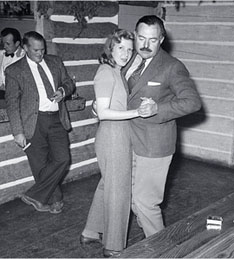 Norman Mailer’s review does not fit my own recollections about That Summer in Paris, read perhaps two years later, back to back with Hemingway’s own posthumously published A Moveable Feast. Here I find myself agreeing much more with a December 2006 article in the Washington Post by book critic Jonathan Yardley, called “Ernest Hemingway’s ‘A Moveable Feast’ Still Satisfies.”
Norman Mailer’s review does not fit my own recollections about That Summer in Paris, read perhaps two years later, back to back with Hemingway’s own posthumously published A Moveable Feast. Here I find myself agreeing much more with a December 2006 article in the Washington Post by book critic Jonathan Yardley, called “Ernest Hemingway’s ‘A Moveable Feast’ Still Satisfies.”
Yardley explains that he was in his mid 20s when he first read A Moveable Feast, when it came out in 1964. And: “I had begun to have second thoughts about most of Hemingway’s novels and deep reservations about his strutting literary persona, but the best of his short stories still seemed to me small masterpieces, and like virtually every young American at that time I was in thrall to Hemingway’s famous prose style.”
Then, as time went by, Jonathan Yardley’s feelings began to evolve still further: “To say that my judgments changed in the ensuing four decades is understatement. I came to regard Hemingway’s style as more self-conscious and mannered than pure, declarative and spare; I realized that in almost all of his writing, he had little of interest to say; and I came to loathe his worst traits of personality and character — meanness that often turned into cruelty; self-centeredness; bluster and braggadocio; exaggerated, showy machismo. Rereading A Moveable Feast in the late 1960s and again in the 1970s, I understood that in certain passages — those dealing with Gertrude Stein, Ford Madox Ford and, most particularly, F. Scott Fitzgerald — it is unforgivably vicious. I also came to understand that Morley Callaghan’s That Summer in Paris (1963) is a better book about the same time and place, not least because Callaghan was a better man than Hemingway, more tolerant of and amused by other people’s shortcomings.”
I think I have gone through some vaguely similar evolution myself, and I agree very much with what Yardley says here.
And yet I agree as well with the ultimate theme of his December 2006 article – that, when all is said and done, A Moveable Feast, like a number of other Hemingway books, “still satisfies.” Or, as Yardley goes on, it retains “a certain irresistible charm. It was a privilege to be able to read about that time in Paris in the words of one of the most important literary expatriates, and it remains so to this day. Reading A Moveable Feast for the fourth (and probably not the last) time, I was struck by how much of it is still agreeable to me.”
9. In Our Time and Michael Palin`s Hemingway Adventure …
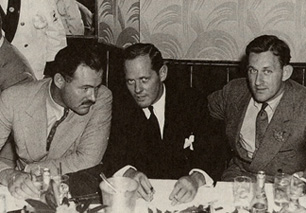 For a great many years after my own youth had come to an end, I had no books by or about Ernest Hemingway in my personal library. As noted earlier, I had lost my original collection of his work in an unfortunate accident. And (again, not unlike Jonathan Yardley, in some degree at any rate) I had come to see this as a sign that fate and a growing sophistication — and my own higher education and ultimate employment — wanted me to move in different directions.
For a great many years after my own youth had come to an end, I had no books by or about Ernest Hemingway in my personal library. As noted earlier, I had lost my original collection of his work in an unfortunate accident. And (again, not unlike Jonathan Yardley, in some degree at any rate) I had come to see this as a sign that fate and a growing sophistication — and my own higher education and ultimate employment — wanted me to move in different directions.
Yet memories of Hemingway s lean and evocative writing and the time when he was the hero of my adolescence never quite vanished. At some point a number of years ago now I attended an early fall conference on the almost magical Mackinac Island in the State of Michigan — not too far north of the old Hemingway summer home on Walloon Lake. Mackinac Island is also a kind of gateway to the so-called Upper Peninsula in the far north of Michigan. And this is the setting for one (or two) of Hemingway’s most enchanting short stories about the wilderness in the North American Great Lakes: “Big Two-Hearted River, Part I” and “Big Two-Hearted River, Part II.”
As it happens, these two pieces come at the very end of Hemingway’s first great short-story collection of 1925, In Our Time. And just before I left for my conference on Mackinac Island I went out and re-purchased a paperback copy of this Hemingway classic, which (like his other major books) remains in print and easy enough to find in any large urban bookstore.
As Jonathan Yardley said about A Moveable Feast, whatever else may or may not be true about Ernest Hemingway as a person, for me In Our Time retains an irresistible charm, and I am pleased that I own a copy of it again. Like many other readers over the past 80 or so years, I still find the two parts of “Big Two-Hearted River” at the end of the book especially alluring. And thanks to subsequent careful scholarship, we now know that the story is not really about a solitary fishing trip on the Two-Hearted River by Nick Adams. It is about a fishing trip Hemingway and two friends took to the Fox River near Seney, Michigan, in the late summer of 1919:
“An author of fiction frequently changes the landscape to suit a story’s mood or theme, and to some degree that is what Hemingway did. After he completed his story in 1924 he excitedly wrote to Gertrude Stein about the Seney countryside: The country is swell, I made it all up, so I see it all and part of it comes out the way it ought to.’ Yet not all is fabricated, for the general layout remains accurate … The boys stayed a week before returning to the Lower Peninsula. They never fished the Two-Hearted River (forty-five miles northeast of Seney), as others have pointed out. Hemingway said he used the name for his story, not from ignorance nor carelessness but because [the name] Big Two-Hearted River is poetry.'”
Whatever else again, Hemingway was right to go for the poetry here. That was the kind of thing he really knew how to do. And it is what makes the two parts of “Big Two-Hearted River” at the end of In Our Time still come alive when you read them today. (Cyril Connolly has summarized this side of Ernest Hemingway quite beautifully as well: “What concerned him was getting down the poetic nature of his own experience, not the construction of a novel as a work of art which would enforce on him its own laws.”)
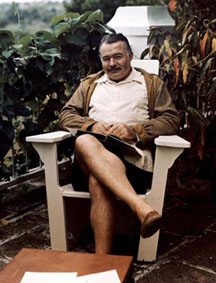 Nowadays I also possess one book about Hemingway – Michael Palin’s Hemingway Adventure, published in 1999. It is the book version of Palin’s TV series of the same name (in both its US and UK versions – where Michael Palin is the northern English gentleman who became famous on the zany BBC series Monty Python’s Flying Circus, 19691975, and has more recently hosted an assortment of TV travel documentaries).
Nowadays I also possess one book about Hemingway – Michael Palin’s Hemingway Adventure, published in 1999. It is the book version of Palin’s TV series of the same name (in both its US and UK versions – where Michael Palin is the northern English gentleman who became famous on the zany BBC series Monty Python’s Flying Circus, 19691975, and has more recently hosted an assortment of TV travel documentaries).
I don’t think I would have bought this book myself. It was kindly given to me by an especially literate friend of my eldest son, to whom I once mindlessly enthused about Hemingway at a bar one night. I think my son’s friend found Michael Palin’s Hemingway Adventure in a remainder bin at some bargain bookstore, and thought why not? In any case, I appreciated his gesture in giving the book to me. I have now read the thing cover to cover, and I am very glad to have it on my shelves, right beside In Our Time. It is one of those cases that justifies the whole idea of gifts — where someone gives you something that you would not have given yourself, for one as it happens flawed reason or another, but that nonetheless works out very well.
One flawed reason I would not have bought Michael Palin’s Hemingway Adventure myself is that there seems to me some almost extreme cognitive dissonance between Ernest Hemingway and someone born in Yorkshire, in the north of England, like Michael Palin. As parochial a judgement as I know this is, I still can’t quite escape it. But what I have come to see clearly enough is that someone like Michael Palin can show you things about Hemingway that more superficially qualified guides may miss.
A particular example from Michael Palin’s Hemingway Adventure stands out in my mind. It relates directly to Jonathan Yardley’s ultimate realization that “in almost all of his writing” Hemingway actually “had little of interest to say” — and to Yardley’s related loathing for Hemingway’s “worst traits of personality and character — meanness that often turned into cruelty; self-centeredness; bluster and braggadocio; exaggerated, showy machismo.”
I myself find that I quite agree with Yardley here, again. Yet it is a virtue of Michael Palin’s TV series (and its accompanying book) that he sometimes manages to show other sides of Hemingway, that make you think in another kind of world, maybe, he might have been both a better person and an ultimately more interesting writer. In Cuba, e.g., Palin interviewed the remarkable Gregorio Fuentes, the former skipper of Hemingway’s fishing boat, Pilar, who was still alive when Palin was making his TV show, at the ripe old age of 101 (and even more impressively, some of us will note with envy, “still smoking” too!).
According to Gregorio Fuentes, who inevitably spent a lot of time with the great American writer, Hemingway “had a human heart for everybody, especially kids and poor people.” And when Michael Palin asked him, in the late 1990s, “What do you think of the American blockade of Cuba. D’you think that will change soon?”, Fuentes replied “I heard Hemingway once say that there was going to be a big war and the whole world was going to defeat the United States and leave them even less powerful than a small island like Cuba.”
Of course, who knows just how true this really is? Gregorio Fuentes had been living in Fidel Castro’s Cuba for some four decades when Michael Palin interviewed him. But especially in the early 21st century this is one of several things that suggest Ernest Hemingway had a largely repressed political side. He was in some almost hidden depths a critic of the USA or even the western world of his day. You can see this in his involvement in the Spanish Civil War, and in his early attractions for Martha Gellhorn. If he had ever found a way of working politics and history into his writing, it might have been considerably more interesting. As things were, Hemingway was in this as in other respects an heir of Mark Twain. In the very end, perhaps, he had become famous by letting America make him into something he did not really want to be.
10. What does he mean for us today?
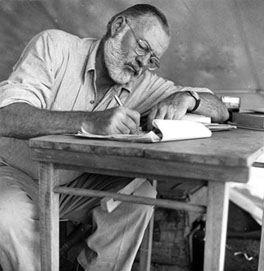 Wikipedia is no authoritative source. But it is often more useful than it is given credit for. And the Wikipedia article on “Michael Palin’s Hemingway Adventure” has something interesting to say. The TV series “has been criticized … as Palin’s weakest travel documentary … mainly because the journey is shown out of order. Palin thought that perhaps the audience didn’t appreciate someone coming between them and Hemingway. Since this series he has reverted back to simply travelling around a geographical area, not shadowing another person.”
Wikipedia is no authoritative source. But it is often more useful than it is given credit for. And the Wikipedia article on “Michael Palin’s Hemingway Adventure” has something interesting to say. The TV series “has been criticized … as Palin’s weakest travel documentary … mainly because the journey is shown out of order. Palin thought that perhaps the audience didn’t appreciate someone coming between them and Hemingway. Since this series he has reverted back to simply travelling around a geographical area, not shadowing another person.”
I have watched the TV series myself, as well as read the book based on it, and I have watched probably most of Michael Palin’s other travel documentaries. I agree that his Hemingway Adventure is not as successful as his other programs. But I think the main reason for this is that it is built around Hemingway’s life, not his books or his writing. And even if the geography of his life is shown in order, it is not going to make good TV.
Again, I think Jonathan Yardley is quite right about Hemingway: “in almost all of his writing, he had little of interest to say.” Yet this is even more true of his life than it is of his writing. And, as Yardley puts it again, the best of his books — and you do still need two hands to count these on — retain “a certain irresistible charm” and still do satisfy. If Michael Palin had based his TV series on Hemingway’s main books, and used them to cover both the geography and the life, I think it would at least have worked much better. (Even if I still can’t quite escape my lamentable and all too parochial feeling that there is some almost extreme cognitive dissonance between Ernest Hemingway and someone born in Yorkshire, in the north of England. And as a final bow to the late great Cyril Connolly, I realize how wrong I am about all this when I read him calling Hemingway’s “Colonel Cantwell in Across the River and Into the Trees … Soames Forsyte in battledress” – for those who may remember anything about John Galsworthy’s Forsyte Saga, on TV or otherwise.)
With all this in mind, I just don’t know how enthusiastic I really am about “For whom the camera rolls: Ernest Hemingway biopic set for big screen” on the guardian.co.uk website. In the very end, I don’t think it is Hemingway’s life that counts for us today. He is not a very likeable character, as many have concluded as they learn more about him. And his life does not, I think, tell us anything very interesting about anything — especially in a day and age when the kind of travelling he did is done by much larger numbers of people than it used to be. What counts are the books he has left behind, that are still enjoyable to read again, now and then, even if most of the time most of them still do have “little of interest to say.”
On a very last note here, however, I have in the course of my research for this article on Hemingway also learned that Gillian Anderson (of X-Files fame) is going to produce and star in a “biopic” about Hemingway’s third wife, Martha Gellhorn.
Martha Gellhorn, it seems to me, may be the kind of writer whose life is in fact more interesting or worth remembering than anything she wrote. (And I say this quite objectively, having never read any of her writing.) I have long been a fan of Gillian Anderson as well. And a new movie in which she plays Martha Gellhorn is something I think I could really enjoy. Meanwhile, if and when the new Hemingway biopic does finally get done, I will probably go to see that too.
* * * *
UPDATE: THAT SUMMER IN SEAN HEMINGWAY’S NEW YORK. In the summer of 2009 the current Scribner imprint of Simon & Schuster published a new edition of Ernest Hemingway’s posthumously published memoir of his youth in Paris, A Moveable Feast. This new edition was edited by Sean Hemingway, a son of Gregory Hemingway, the second child of Ernest Hemingway’s marriage to his second wife, Pauline Pfeiffer.
Sean Hemingway is an associate curator at the Metropolitan Museum of Art in New York. He previously edited anthologies of his grandfather’s writings on war and hunting. The ostensible main objective of his new 2009 edition of A Moveable Feast has been to present his grandmother in a more favourable (or “nuanced and truthful”) way than the original 1964 edition, which had been edited by Ernest Hemingway’s fourth wife, Mary.
The argument for this kind of revision is that the original edition of A Moveable Feast had effectively been cobbled together by Mary Hemingway, “from shards of the unfinished manuscript” Ernest left behind at his death in 1961.
In particular, Mary had “created a final chapter that dealt with the dissolution of Hemingway’s first marriage [to Hadley Richardson] and the beginning of his relationship with Pauline Pfeiffer, building some of it from parts of the book he had indicated he did not want included.” Among the changes Sean Hemingway has made “is removing part of that final chapter from the main body of the book and placing it in an appendix, adding back passages from Hemingway’s manuscript that Sean believes paint his grandmother in a more sympathetic light.”
That at least is the story told by Sean Hemingway. Two articles that challenge this story also appeared this past summer.
The first, in the New York Times, was by Ernest Hemingway’s old friend and literary colleague, A.E. Hotchner. He reports that “Ernest … gave me the completed manuscript of the Paris book to give to Scribner’s president, Charles Scribner Jr.” before his death. The “manuscript was not left in shards but was ready for publication,” although “Ernest died before the publication of the book could go forward … After his death, Mary, as executor, decided that Scribner should proceed with the publication. Harry Brague was the editor. I met with him several times while the book was in galleys.” Hotchner believes that Sean Hemingway’s new edition of the book is not something his grandfather would have wanted — and is critical of the current Scribner’s imprint for going ahead with the project.
The second article, in the Huffington Post, was by the investigative reporter/editor and former publisher Thomas Lipscomb. He has had his own direct experience, with Ernest Hemingway’s old friend, the “brilliant cantankerous retired general … C. T. ‘Buck’ Lanham” (the model for Colonel Cantwell in Across the River and Through the Trees), and with Ernest’s first wife Hadley Richardson. Lipscomb also points to an article Mary Hemingway herself published in the New York Times in 1964, when A Moveable Feast first appeared. On the basis of all this Lipscomb concludes: “there is no literary justification for the hack job Sean [Hemingway] has made of a literary masterpiece … The returning Stuarts after their Restoration in 1670 [well actually 1660, but a long time ago in any case] dug up Oliver Cromwell’s body, the man they saw as the author of their misfortune, and hung it in chains. As a representative of the Pfeiffer-Hemingway clan, Sean has elected to dig up the literary corpus of his grandfather’s work and rearrange it to suit his puerile personal fancies.”
I have not looked at Sean Hemingway’s so-called “restored edition” of A Moveable Feast myself. And in any case I do not know at all enough about the background to have an independent opinion. But Hotchner and Lipscomb do seem to make compelling arguments. I am grateful to my esteemed colleague, D.A.M. Metis, for drawing their articles to my attention. (L.F.B.)
* * * *
Photograph Credits
The photographs are numbered here in the order in which they appear in the text above:
(1) The Hemingways and Spencer Tracy at La Florida [Floridita] … La Florida [Floridita], Havana, Cuba … Copyright: Public Domain … Credit: Photograph in the Ernest Hemingway Photograph Collection, John F. Kennedy Presidential Library and Museum, Boston.
(2) Birthplace of Ernest Hemingway, 339 North Oak Park Ave., Oak Park, Il … Oak Park Journal photo
(3) Young Ernest with fish at Walloon Lake … Michigan History: Up North with the Hemingways … Photo credit: Clarke Historical Library/Jim Sanford
(4) Ernest Hemingway, Milan 1918 … Milan, Italy … Copyright: Public Domain … Credit: Ernest Hemingway Photograph Collection, John F. Kennedy Presidential Library and Museum, Boston.
(5) Wedding of Hadley Richardson and Ernest Hemingway … Horton’s [Horton] Bay, Michigan … September 03, 1921 … Copyright: Public Domain … Credit: Ernest Hemingway Photograph Collection, John F. Kennedy Presidential Library and Museum, Boston.
(6) Ernest Hemingway’s 1923 passport (detail) … Copyright: Public Domain … Credit: Ernest Hemingway Collection, John F. Kennedy Presidential Library and Museum, Boston.
(7) The Hemingways at a cafe, Pamplona, Spain, 1925 … Pamplona, Spain … Copyright: Public Domain … Credit:Photograph in the Ernest Hemingway Photograph Collection, John F. Kennedy Presidential Library and Museum, Boston.
(8) Ernest and Pauline Hemingway in Spain, 1927 … San Sebastian, Spain … Copyright: Public Domain … Credit:Photograph in the Ernest Hemingway Photograph Collection, John F. Kennedy Presidential Library and Museum, Boston.
(9) Key West — Ernest Hemingway’s House … Travel Pod … The web’s original travel blog.
(10) Ernest and Pauline Hemingway on Ship’s Deck … Original caption: Photo shows Ernest Hemingway, the well-known writing gentleman, with his second wife Pauline. They were among the passengers on the S.S. Paris on its arrival here yesterday, April 3rd. The Hemingways visited, and hunted big game in Africa … Image: Bettmann/CORBIS … Collection: Bettmann … Standard RM … Date Photographed: April 3, 1934 … Location Information: New York, New York, USA
(11) Ernest Hemingway on safari in Tanganyika, 1934 … Tanganyika, Africa … Copyright: unknown … Credit: Ernest Hemingway Photograph Collection, John F. Kennedy Presidential Library and Museum, Boston.
(12) Ernest Hemingway (far right) with John Dos Passos (far left), Joris Ivens (back to camera), and Sidney Franklin in Madrid during the Spanish Civil War … Encyclopaedia Britannica … Bettmann/Corbis
(13) Ernest Hemingway with Martha Gellhorn on their honeymoon in Honolulu in 1940, at Halehulani Hotel … “Hemingway, Your Letter Has Arrived” … CARLOS Tiger without Time … A Blog where show you miscellany about my ideas, experiences, thoughts, humor and curiosities
(14) Ingrid Bergman, For Whom the Bell Tolls … Dr. Macro’s High Quality Movie Scans, The Annex, Ingrid Bergman …
(15) Finca Vigia, Ernest Hemingway’s old house in Cuba … Photograph: Alamy … “What would Papa say?” … guardian.co.uk … The Observer, Sunday 29 July 2007.
(16) Ernest and Pilar, Havana Harbor … explorekeywesthistory.com …
(17) Hemingway in the Second World War, Deux Magots cafe, Paris, France … cropped from: Ernest Hemingway with American writer Janet Flanner in Paris, France … CREDIT: Scherman, David, photographer … Copyright Time, Inc. … Prints and Photographs Division, Library of Congress.
(18) Ernest and Mary Hemingway in Sun Valley, 1947 … Sun Valley, Idaho … Copyright: not known … Credit:Photograph in the Ernest Hemingway Photograph Collection, John F. Kennedy Presidential Library, Boston.
(19) The Old Man and His Fishing Boat … Hemingway on Pilar, c. 1950s … “Quotes of Ernest Hemingway 4,” CARLOS Tiger without Time … A Blog where show you miscellany about my ideas, experiences, thoughts, humor and curiosities
(20) Ernest and Mary Hemingway with baby Grant’s gazelle … Kenya, Africa, 1953 … Copyright: Copyright Earl Theisen Archives, Agoura Hills, California … Credit: Earl Theisen photograph in the Ernest Hemingway Photograph Collection, John F. Kennedy Presidential Library and Museum, Boston.
(21) Ernest Hemingway, endurance drinker, greets Fidel Castro, endurance orator … late 1950s … “The Daiquiri” … bunnyhugs.org
(22) Luncheon at “La Consula”, 1959 … Malaga, Spain … Copyright: Public Domain … Credit: Photograph in the Ernest Hemingway Photograph Collection, John F. Kennedy Presidential Library and Museum, Boston.
(23) Hemingway gathering firewood for Idaho’s harsh winter … The Ernest Hemingway Collection.
(24) Ernest and Hadley Hemingway, winter 1922 … Chamby, Switzerland … Copyright: Public Domain … Credit: Photograph in the Ernest Hemingway Photograph Collection, John F. Kennedy Presidential Library and Museum, Boston.
(25) Ernest Hemingway on safari, 1934 … Serengeti Plain … Copyright: Public Domain … Credit:Photograph in the Ernest Hemingway Photograph Collection, John F. Kennedy Presidential Library and Museum, Boston.
(26) Ernest Hemingway [left] … during the Spanish Civil War, about 1937 … “Hemingway, Your Letter Has Arrived” … CARLOS Tiger without Time … A Blog where show you miscellany about my ideas, experiences, thoughts, humor and curiosities
(27) Martha Gellhorn and Ernest Hemingway in Sun Valley, Idaho, at the time of their wedding, November 1940. The photo was taken for Life magazine … Copyright 2006 The New York Times Company
(28) Ernest Hemingway [left], Sherman Billingsley and John O’Hara [right] at the Stork Club, photograph from the private collection of the Billinsgley family, courtesy of Shermane Billingsley … “One night in 1940, back in New York, Hemingway had grandiosely tried to pay his bar bill at the Stork with a $100,000 royalty check he had gotten for the screen rights to For Whom the Bell Tolls. (A hundred thousand dollars in 1940 would be $1.2 million today.) Billingsley shook his head, no way he could cash that check, not then. But if Hemingway could wait till closing time. Then, amazingly, Billingsley did cash it, although it is hard to imagine how, with the club then grossing officially anyway by Billingsley’s account, $3,500 a night.”
(29) Ernest Hemingway at the Finca Vigia in San Francisco de Paula, Cuba, 1947 … The Ernest Hemingway Collection.
(30) Ernest Hemingway in Kenya, 1953 … Copyright: Earl Theisen Archives, Agoura Hills, California … Credit: Photograph by Earl Theisen for LOOK Magazine, copyright Earl Theisen Archives, in the Ernest Hemingway Collection, John F. Kennedy Presidential Library and Museum, Boston.
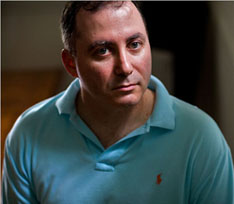

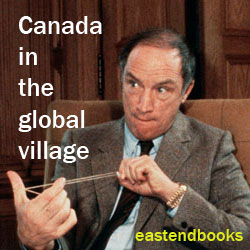
Thank you..really informative!!
Hemingway was quite political, but not doctrinaire, he did not go in for brainwashing, and did not think anyone had “the answer.”
It is sad to see someone say in print that Hemingway had little of interest to say. It’s kind of like saying, African art is crude, or Mark Twain wrote boy’s adventure books, or Paul Krugman’s economic work is shaped by his liberal political views. All those statements are true for some people…and only from a very narrow viewpoint.
Anyone who has spent time on the water around the Keys or Cuba and is not profoundly moved by Hemingway’s descriptions of the land and the water has a heart of stone and a head of wood. I for one am very grateful the family published so much post-humously. Islands in the Stream is not a happy book. It is the story of an aging man with nothing left inside but the ability to hurt people, especially those he loves. I suppose if you read this while there is still enough youth in you that life still seems to have much to offer, or you have reconciled yourself to gently sliding slowly into oblivion taking cruises and sharing Thanksgiving with the family, while cushioned by a comfortable retirement, then you might indeed say that Hemingway had amazingly little of interest to say.
Hemingway wrote those last years after the accident despite having what we now know is brain damage from the very numerous serious concussions he had suffered throughout his life; from boxing; from war; from car and plane and boat accidents (he had a bad fall in a heavy sea on his boat Pilar in which he describes the classic symptoms of a serious concussion. He also described concussions from ww2 and African plane crashes). Hemingway suffered an amazing amount of physical damage in his life, even having once been attacked by an owl that sank its talons into his abdomen and could not be induced to let go. It is miraculous the work he produced in his last years despite the brain damage and the general damage done to his body, not only by injuries, but by hard living and very hard drinking, especially in his last years as it helped him cope with constant pain. The mental acuity of all writers, as with all persons, declines in middle age. That Hemingway was able to produce what he did in his fifties while the brain damage was certainly digging in, is a testament to his endurance and will-power.